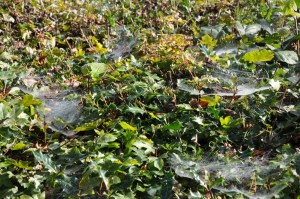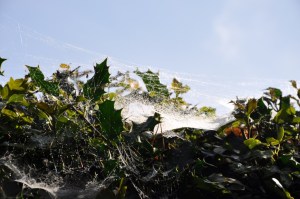Heading from summer to autumn, this is the first blog from the autumn and dates from 28 September 2013.
After a long hot summer I knew that autumn had finally arrived when the morning’s dew remained captured on the delicate filaments of the Spider webs well into the following morning, rather than disappearing at first light. Overnight the Spiders had been working hard in our hedge, to make the top surface a bejewelled carpet of webs, scattered like a fine gossamer blanket that had been snagged by the upright shoots of the hedge when blown in the wind.
 Spider Webs – 28 September 2013 (Copyright Carol Jones)
Spider Webs – 28 September 2013 (Copyright Carol Jones)
In the morning sunlight the fine threads were covered with an amazing array of tiny droplets of dew, it was as though someone had been out all night threading tiny iridescent beads onto the threads. In the morning sunshine each of these beads then reflected the sunlight in all directions, producing an array of tiny rainbows. A temporary but very beautiful effect that didn’t last long, for even this late in the year the morning dew does not last forever and the strength of the autumn sun soon evaporated them.
 A Spider’s Web Covered in Iridescent Beads – 28 September 2013 (Copyright Carol Jones)
A Spider’s Web Covered in Iridescent Beads – 28 September 2013 (Copyright Carol Jones)






